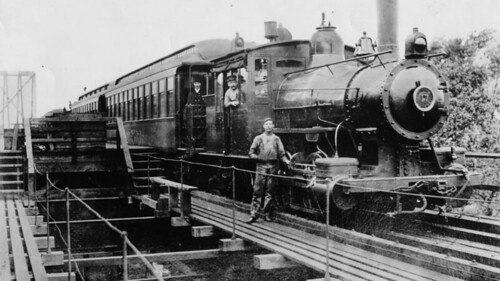Chicago Elevated, "L," is 125 years old
A stock criticism of transit foes is that rail transit is a 19th century technology, implying that it hasn't changed ever since it was first invented. Oddly enough, they seem to forget that automobiles are a 19th century technology too and that both technologies have improved over time.
What the critics really mean is that rail transit is "mass transit" and aims to move many people, simultaneously, in large vehicles (buses, train cars of various sorts), while the automobile enables personal mobility.
From a transportation system standpoint, in dense places, it's not possible to move large numbers of people at the same time, in quantities of one or two people, in boxes (cars) taking up about 150 square feet on the roads, when by contrast three 150 square foot boxes, organized as a bus, can move 50 people or more at the same time.
The space requirements to move the same number of people in different modes is captured in this image, which is based on an exercise in association with a planning process in Freiburg, Germany in the early 1970s.

The Lake Street Elevated Railroad, shown in 1894, with a steam-powered locomotive. It went into service on Nov. 6, 1893, from a terminal over Market Street — now Wacker Drive — at Madison Street, north to Lake Street and west to California Avenue. Avenue. Shown sitting eastbound is No. 17, one of 35 engines bought for initial service from Rhode Island Locomotive Works in Providence. Many of the first 125 wooden coaches, built by the Gilbert Car Co., of Troy, N.Y., and Pullman, were motorized when the line was electrified late in 1896. CTA photo.
That being said, the Chicago Elevated is definitely a 19th century technology, elevated rather than underground so it can be seen sometimes as visual blight, noisy because it's steel on steel (trains are quieter on concrete abutments because they don't make the same kind of noise when trains pass over it), and in some places, immediately abutting residential and other properties, which is definitely a quality of life inhibitor the closer you live to it.
The cost to replace the track bed with concrete is beyond the ability of the State of Illinois to fund.
But it works, and works well. With the decline in WMATA Metrorail ridership due to reliability and maintenance issues, now the Chicago Transit Authority--which has above-ground elevated trains as well as some subway--just edges the DC area in terms of daily ridership, by a couple thousand riders per day, making it, for the time being at least, the second busiest rail transit system in the U.S.
Yesterday, the Chicago Tribune ran a story on the anniversary. The article includes a couple photo galleries.
-- "Chicago's elevated train system started 125 years ago"
Originally the trains were powered by locomotives. Later electric power was implemented.
Back in the day when there was interurban transit (today, the South Shore Line connecting Northern Indiana to Chicago is the only interurban that continues to function), some of the lines interconnected with the Loop Elevated Track system.
The great book Terminal Town, on the history of Chicago's transportation terminals of all types (railroad, transit, ship, bus, interurban, airports) discusses those interconnections.

“Terminal Town: Celebrating 75 Years of Travel to the Windy City,” exhibit on display at Thompson Center by the DePaul University’s Chaddick Institute for Metropolitan Development. Photo by Jamie Moncrief/DePaul University.
Many people don't know that one of the consolidators of the Chicago rail transit system went on to become a leading developer of the London Underground. The Economist ("Conquistador of Metroland: How the vision and cunning of an unknown American changed the shape of London") argues that Charles Yerkes and the London Underground significantly shaped Greater London's land use and mobility practices.

A different interaction between London and Chicago transit systems likely shaped the great poster-based transit promotion advertising program of the Chicago transit system
In the 1920s, Samuel Insull, who controlled Midwest utilities and interurban systems, also controlled the Chicago transit system. He was born in England, and travelled frequently between the US and London. It's believed that his seeing the various London Underground promotional posters led to the Chicago system creating a similar program ("A True Visionary Gives Chicago A Landmark Branding Campaign Circa 1920-30," Print Magazine).
Labels: transit, transit marketing, transportation infrastructure, urban design/placemaking, urban history, urban revitalization



0 Comments:
Post a Comment
<< Home